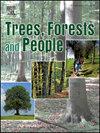利用山脊回归和嵌套线性混合效应模型重建和比较大巴哈马飓风前时期的松林年龄
IF 2.7
Q1 FORESTRY
引用次数: 0
摘要
大巴哈马岛松树林的早期历史生态记录表明,1944 年至 1960 年期间,巴哈马在伐木过程中对岛上的成熟松树进行了大规模的商业砍伐,大大减少了大巴哈马岛的松树数量。伐木后时期的大飓风造成了岛上松树数量的进一步减少。大巴哈马岛上约有 4 300 万棵松树。在 2004 年和 2005 年大飓风之前,大巴哈马岛约有 4 300 万棵松树。本研究采用脊回归和嵌套线性混合效应模型(包含随机截距作为方差-协方差结构)来重建和比较大巴哈马松林在不同区域(多利安飓风前死亡区、多利安飓风后死亡区和多利安飓风后活松区)的年龄。统计结果表明,2004 年大巴哈马成熟松林(DBH ≥ 10 厘米)的年龄在 38 至 49 岁之间。这些松树苗是 1950 年至 1970 年期间在大巴哈马伐木时代和伐木时代末期发芽的松树苗。类内相关系数(ICC [1])表明,线性混合效应模型(LMM)中的嵌套效应(域内调查地块)解释了松林年龄分组效应所捕获的总变异的 33.8%(ICC [1] = 0.338)。固定因子和随机因子(预测因子)解释了各领域平均松林年龄总变异的 48.8%(Rc2 = 0.488)。与固定效应因子相比,固定效应因子对响应变量变异的解释比例要小得多(Rm2 = 0.227)。跨域的平均松林年龄具有统计学意义(F 2, 300.34 = 79.94; p <0.0001),表明整个松树景观中松树年龄的特定年龄变化。2004 年、2005 年和 2019 年的大飓风进一步改变了松树林的树龄结构,导致整个大巴哈马岛散布着不连续的松树枯死林片段。城市发展造成的小规模森林砍伐继续影响着大巴哈马岛的松林年龄结构。鉴于伐木和飓风都会导致地貌结构发生变化,大巴哈马岛的松林应由树龄不均的松树植被组成。树龄不均的松树应该出现在有过多次伐木历史的地区和北海岸,因为 2004 年和 2005 年的大飓风对北海岸的影响最大。这项研究提供了大巴哈马松林在大飓风前的历史背景。本文介绍的研究结果为我们了解巴哈马松林提供了重要信息,说明了大巴哈马松林在大飓风前这一重要时期的松树密度和松林年龄。本文章由计算机程序翻译,如有差异,请以英文原文为准。
A reconstruction and comparison of Grand Bahama pine forest age during the pre-major hurricane era using ridge regression and nested linear mixed-effects model
Early historical-ecological records of the pine forest on Grand Bahama indicated that large-scale commercial removal of the mature pine trees from the island during logging in The Bahamas substantially reduced the pine population in Grand Bahama from 1944 to 1960. Additional losses of the pine population on the island were results of the major hurricanes in the post-logging era. There were ca. 43 million pine trees in Grand Bahama before the 2004 and 2005 major hurricanes. This study uses ridge regression and a nested linear mixed-effects model (with a random intercept included as the variance-covariance structure) to reconstruct and compare Grand Bahama pine forest age across different domains (pre-Dorian dead, post-Dorian dead, and post-Dorian live pine areas). Statistical results revealed that the mature pine forest (DBH ≥ 10 cm) in Grand Bahama in 2004 ranged in age from 38 to 49 years old. These are the pine seedlings that germinated between 1950 and 1970 during and at the end of the logging era in Grand Bahama. The intraclass correlation coefficient (ICC [1]) indicated that the nesting effect (survey plots within domains) in the linear mixed-effects model (LMM) explained 33.8% (ICC [1] = 0.338) of the total variance captured by the grouping effect of pine forest age. Both the fixed and random factors (predictors) explained 48.8% ( = 0.488) of the total variance of the mean pine forest age across domains. This compared better to the fixed-effects factor, which alone explained a much smaller percentage of the variation of the response variable ( = 0.227). The mean pine forest age was statistically significant across domains (F 2, 300.34 = 79.94; p < 0.0001), indicating age-specific variation in pine tree age across the pine landscape.
From 1950 to 1970, Grand Bahama pine forest age underwent radical shifts due to extensive commercial harvesting during the logging era (1944–1960). The major hurricanes in 2004, 2005, and 2019 further changed the pine forest age structure, resulting in discrete fragments of dead pine forests scattered throughout Grand Bahama Island. Small-scale deforestation from urban growth continues to impact the pine forest age structure in Grand Bahama. Given that both logging and hurricanes result in structural changes to landscapes, the pine forest in Grand Bahama should consist of uneven-aged pine vegetation. The presence of uneven-aged pine trees should occur in areas with a repeated history of logging and along the north shore, where the effects of the 2004 and 2005 major hurricanes were the most impactful. This study provides historical contexts of Grand Bahama pine forest in the pre-major hurricane era. The findings presented here add to our understanding of the Bahamian pine forest by providing critical information on the pine tree density and pine forest age in Grand Bahama in the pre-major hurricane era, an era of significant importance.
求助全文
通过发布文献求助,成功后即可免费获取论文全文。
去求助
来源期刊

Trees, Forests and People
Economics, Econometrics and Finance-Economics, Econometrics and Finance (miscellaneous)
CiteScore
4.30
自引率
7.40%
发文量
172
审稿时长
56 days
 求助内容:
求助内容: 应助结果提醒方式:
应助结果提醒方式:


